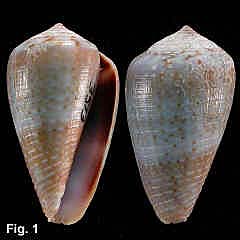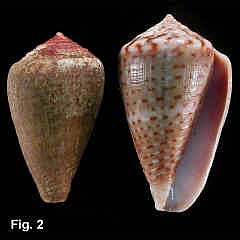|
|
|
|
|
Conus aplustre Reeve, 1843 Description: Shell medium to heavy in weight, low conical in shape. Body whorl convex above, straight or slightly concave towards the base; base with spiral ridges on the bottom third or half, remainder smooth . Shoulder rounded, spire low to moderately high, either straight or slightly concave. Spire whorls with 5-8 spiral threads. Aperture slightly wider anteriorly, outer lip straight or convex. Background colour bluish-grey, with evenly spaced spiral lines of alternating white and brown, usually present on the entire body whorl, but sometimes restricted to the anterior end; sometimes with 2 or 3 broad spiral bands of pinkish-brown; aperture violet or brown. Size: Up to 33 mm in length, commonly 20-25 mm. Distribution: Endemic to Australia; Hastings Point (east of Murwillumbah), NSW, to Broulee, NSW. Some old records of doubtful accuracy extend the range into southern Queensland. Habitat: Under rocks on exposed rocky shores, at low tide level. Common. Comparison: The three species C. anemone, C. papilliferus, and C. aplustre occur, apparently together, on exposed rocky shores of NSW, and although only moderately common alive, are of frequent occurrence as beach shells. C. anemone, which is very common in South Australia and Victoria, is less common than C. papilliferus in NSW. It may be separated from the other two species by its relatively tall and bulbous shape, and in having spiral ribbing on all of the body whorl. C. papilliferus and C. aplustre are similar to each other in shape - low conical with only slightly convex sides - but at the extremes are easily separated; large, lightweight specimens of C. papilliferus with mottled colour pattern show little resemblance to small, heavy specimens of C. aplustre with the typical regular pattern of spiral lines. However, at the other extreme the two species can be difficult to separate. Specimens occur commonly with areas of the lined pattern of C. aplustre and the patchy pattern of C. papilliferus on the same shell. Generally C. papilliferus is a lighter shell than C. aplustre, and when it has spiral rows of brown dots they are smaller than in C. aplustre and do not alternate with white dashes. Fig. 1 Broomes Head, NSW (DLB3573) Fig. 2 Long Reef, Collaroy, Sydney, NSW (C.135727, both specimens) |

